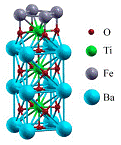Department of Physics and Astronomy: Publications and Other Research

Evgeny Tsymbal Publications
ORCID IDs
Tsymbal http://orcid.org/0000-0002-6728-5561
Document Type
Article
Date of this Version
2-20-2019
Citation
Physical Review Letters (2019) 122: 077203
doi: 10.1103/PhysRevLett.122.077203
Abstract
Topological antiferromagnetic (AFM) spintronics is an emerging field of research, which exploits the N´eel vector to control the topological electronic states and the associated spin-dependent transport properties. A recently discovered N´eel spin-orbit torque has been proposed to electrically manipulate Dirac band crossings in antiferromagnets; however, a reliable AFM material to realize these properties in practice is missing. In this Letter, we predict that room-temperature AFM metal MnPd2 allows the electrical control of the Dirac nodal line by the N´eel spin-orbit torque. Based on first-principles density functional theory calculations, we show that reorientation of the N´eel vector leads to switching between the symmetryprotected degenerate state and the gapped state associated with the dispersive Dirac nodal line at the Fermi energy. The calculated spin Hall conductivity strongly depends on the N´eel vector orientation and can be used to experimentally detect the predicted effect using a proposed spin-orbit torque device. Our results indicate that AFM Dirac nodal line metal MnPd2 represents a promising material for topological AFM spintronics.


Comments
Copyright 2019, American Physical Society. Used by permission